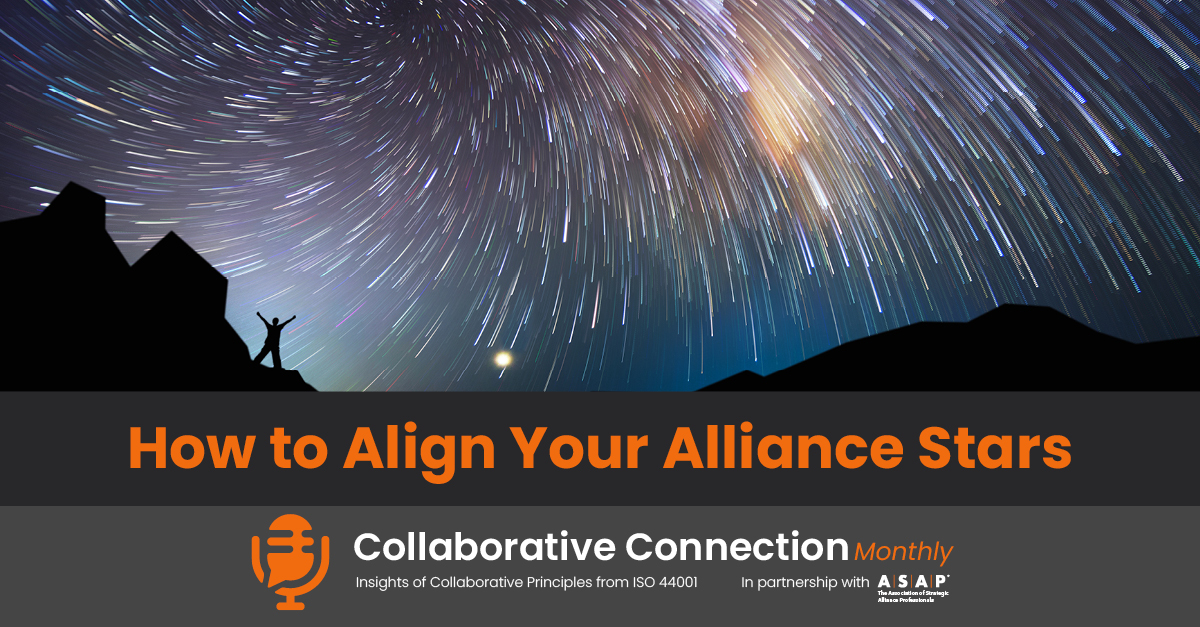How to Align Your Alliance Stars
Stakeholder alignment. So important, yet so time-consuming.
“Informal surveys indicate that alliance managers spend on the order of 70 percent of their time managing alignment of internal stakeholders. That’s a lot of time—time that could be spent creating value, innovating, or driving revenue,” said moderator Greg Burge, CSAP, principal of Collaborative Partnering Services.
“If you don’t have that alignment, then people are working toward different goals, they don’t understand why what they’re doing is important or how it contributes to corporate value,” said Norma Watenpaugh, CSAP, founding partner of Phoenix Consulting Group. “To the extent that you have everyone know their roles, responsibilities, contributions, what they’re supposed to be doing, and how they are rewarded and reorganized for it, things go smoother [and] your alliance performs better.”
Fortunately, there are tools that can help alliance managers get the folks in the alliance practice, other divisions, senior management, and at the partner rowing in unison. Many of these practices were covered in the latest Collaborative Connection Monthly webinar, “Stakeholder Alignment—from Sandy Gears to a Well-Oiled Partnering Machine,” for which Burge was delivering the introduction to Watenpaugh’s discourse on how to optimally use, and perhaps reduce, that 70 percent of a partnering professional’s time dedicated to this important facet of alliance management.
“When Everyone Is on the Same Page, This Is the Page”
At the broadest level, stakeholder alignment success depends on a series of interlocking elements. The alignment model Watenpaugh showcased started with getting high-level partner and corporate strategy in lockstep. From there, an operations plan supports those interlinked alliance and company objectives, and the people on the front lines executing that plan must be clear on their roles and responsibilities. How do you get them to put senior management’s vision into practice? By offering the appropriate unique motivations and incentives for each stakeholder.
Obviously, all of this is easier said than done, but Watenpaugh offered a few tips for structuring the process. As always, senior leader sponsorship is the most effective way to grease the skeptics’ wheels and get them to understand how alliances create value and fit into that aforementioned corporate strategy—“[executive sponsorship] lends gravitas in managing stakeholders,” she said. And, yes, your typical governance mechanisms—committee meetings and other rules of engagement—always help avoid mission drift.
Still, Watenpaugh also pushed attendees to compose a detailed partner team charter that includes a consolidated summary of key agreements, basic value proposition of joint solutions, top objectives, key metrics, names of team leaders, high-level governance cadence, and the agreed-upon norms, values, and operating principles that will guide everyone’s work.
“[The charter is] a top sheet to your business or operational plan,” said Watenpaugh. “I like to say, when everyone is on the same page, this is the page.”
Charting the Usual Suspects
Of course, while a charter will help get an alliance off on the right foot and provide a critical frame of reference throughout the duration of the relationship, misalignment is often inevitable along the way. A detailed stakeholder map helps course correct when partners veer away from their mission. Watenpaugh recommended grouping key players into four groups based on their level of accountability and commitment:
- “Champions” – Executives who both believe in the alliance and are directly responsible for its success. Ideally, your executive sponsors would fall into this category.
- “Hostages” – People appointed to oversee collaborations that they don’t necessarily believe in, perhaps because the mission doesn’t resonate with them or they can’t see how the collaboration supports broader corporate goals.
- “Cheerleaders” – Those who are “gung-ho” about a partnership that they don’t necessarily have any say in. These folks make good allies, but “they can be fickle. Things go sideways or they get distracted, and you lose them,” said Watenpaugh.
- “Detractors” – People within the partnering organizations who have nothing to do with the day-to-day operation of the collaboration and similarly want their respective companies to have nothing to do with it either; Watenpaugh gave the example of someone in R&D resenting the idea of integrating a partner’s functionality rather than developing it in-house because they are afflicted with “not-invented-here syndrome.”
Watenpaugh noted that some people take these stakeholder maps further by color-coding them or drawing lines between people to illustrate which relationships are strong and which ones are shaky. She also rates attributes for each executive like commitment, accountability, or influence on a one-to-five scale—a “five” would influence all cross-functional divisions, while a “one” would only influence themselves, for example.
To get to know these players, Watenpaugh urged alliance managers to open a dialogue with each one of them to answer a few essential questions.
“What is your job? What are you accountable for? At the end of the day, how do you get measured and rewarded?” she said. But be careful: “If it comes across as an interrogation, you are going to lose them.”
Drilling down into that last question, Watenpaugh told a story of a client who came into a large sum of marketing dollars provided by a partner. With twice the budget to drive warmer leads, the marketing group quickly vaulted into the “Champions” category.
“Understanding what people’s motivations are, and how they can be aligned is a great step forward. You build those internal relationships. You build trust in the organization. Understanding what the alliance objectives are and how [stakeholders] can contribute will ultimately help them,” said Watenpaugh.
Be on the lookout for more details on the next webinar in the Collaborative Connection Monthly series, taking place Sept. 1.

